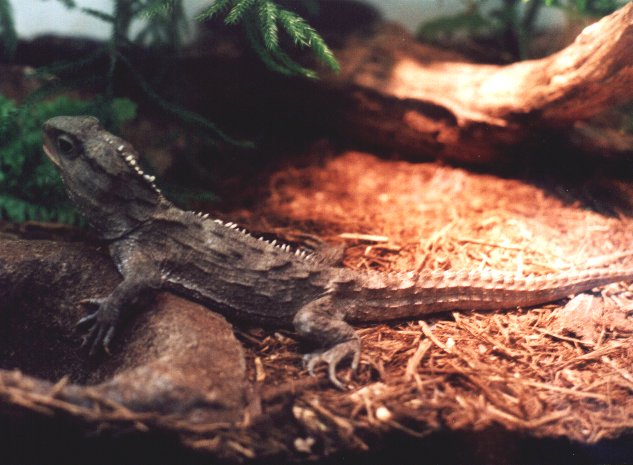

Sphenodon punctatus
Tuataras are found on approximately 30 small, relatively inaccessible islands off the coast of New Zealand. The species was once widely distributed throughout New Zealand, but became extinct on the mainland before the arrival of European settlers. Tuataras differ from other reptiles by possessing a third eye that contains a rudimentary lens and retina and is connected to the brain by a nerve. However, it is covered with opaque scales and the formation of an image would be impossible. Some scientists believe that this third eye may function as a light sensor, influencing the amount of time a tuatara spends basking.
Tuatara teeth, also, are different from those of other reptiles. They have a single row of teeth in the lower jaw, and a double row in the upper jaw, the bottom row fitting neatly between the two upper rows. Little more than serrations of the jaw, they are not replaced when worn out or damaged, and some old tuataras are virtually toothless, chewing their food between smooth jaw bones.
Tuataras also differ from other animals, in their enormously slow reproduction rate. The process of egg formation takes a female four years, sometimes more, which is longer than in any other reptile. Then the eggs take 12 months to hatch.
One more odd thing about the tuatara as a reptile is its preferred range of temperature. It prefers temperatures below 40 degrees Fahrenheit, and operates quite well in sub-freezing temperatures. This is odd, because most reptiles go into hibernation at temperatures like that. But the tuatara thrives, and even suffers at higher temperatures. The tuatara has a very slow metabolism, and goes about life carefully and meticulously. It's not uncommon for an individual to live for over 100 years.
The picture above was taken at St. Louis zoo, in May 2002.
Genus Sphenodon
Family Sphenodontidae
Order Rhynchocephalia
Class Reptilia
Subphylum Vertebrata
Phylum Chordata
Kingdom Animalia
Life on Earth
Index